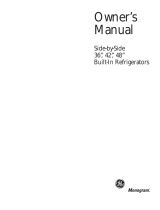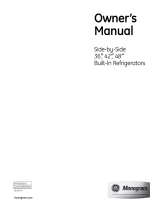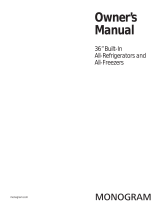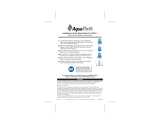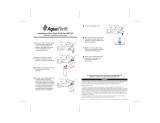
7
IMPORTANTES INSTRUCTIONS DE SÉCURITÉ
LISEZ ET SUIVEZ SOIGNEUSEMENT CES MESURES DE SÉCURITÉ.
CONSERVEZ CES INSTRUCTIONS
UTILISATION DE RALLONGES ÉLECTRIQUES
Nous vous recommandons fortement de ne pas utiliser de rallonge électrique, à cause d’un danger de risques possibles de sécurité
dans certaines conditions. Cependant, si vous devez absolument utiliser un cordon rallonge électrique, il est absolument requis que
vous utilisiez un cordon rallonge trifilaire, avec mise à la terre, certifié UL (aux États-Unis) ou ACNOR (au Canada), avec prise et
fiche à trois conducteurs, et à notation électrique de 15 ampères (minimum) et 120 volts.
BRANCHEMENTS ÉLECTRIQUES
AVERTISSEMENT
Risque de choc électrique.
Branchez l’appareil dans une prise triple avec terre.
Ne retirez pas la broche de terre.
N’utilisez pas d’adaptateur.
Le non-respect de ces instructions peut entraîner des
risques d’incendies, des chocs électriques
ou la mort.
Ne coupez pas ou n’enlevez pas, sous aucun prétexte, la troisième broche de mise à la terre du cordon
d’alimentation. Pour des raisons de sécurité, cet appareil doit être correctement mis à la terre.
Le cordon d’alimentation de cet appareil est équipé d’une fiche
à trois broches (pour une mise à la terre) qui s’adapte à la prise
de courant standard à 3 broches (pour une mise à la terre) pour
minimiser les risques de chocs électriques par cet appareil.
Faites vérifier la prise murale et le circuit électrique par
un électricien qualifié pour s’assurer que le système est
correctement mis à la terre.
Dans le cas d’une prise biphasée, l’installateur a la
responsabilité et l’obligation de la remplacer par une prise
triphasée correctement mise à la terre. N’utilisez pas
d’adaptateur.
Le réfrigérateur doit toujours être branché à sa propre prise
électrique d’une tension nominale correspondant à celle
indiquée sur sa plaque signalétique.
Une alimentation électrique à 115 volts CA, 60 Hz, avec
un fusible de 15 ou 20 ampères et une mise à la terre est
nécessaire. Ceci permet d’obtenir un meilleur rendement et
évite de surcharger les circuits électriques du domicile qui risque
d’occasionner un incendie en surchauffant.
Ne débranchez jamais le réfrigérateur en tirant sur le cordon
d’alimentation. Prenez toujours fermement la fiche en main et
tirez pour la sortir de la prise.
Réparez ou remplacez immédiatement tout cordon électrique
usé ou endommagé. N’utilisez pas un cordon fissuré ou
présentant des dommages dus aux frottements soit sur sa
longueur ou aux extrémités.
Lorsque vous éloignez votre réfrigérateur du mur, faites
attention à ne pas le faire rouler sur le cordon d’alimentation
afin de ne pas l’endommager.
MISE AU REBUT APPROPRIÉE DE VOTRE ANCIEN RÉFRIGÉRATEUR
AVERTISSEMENT
Un enfant risque de suffoquer ou d’y être emprisonné.
Démontez les portes du compartiment de réfrigération et du compartiment de congélation du réfrigérateur, avant
mettre celui-ci au rebut. Le non-respect de cette recommandation peut entraîner l’enfermement d’un enfant qui peut
entraîner la mort ou des lésions cérébrales.
Les enfants pris au piège ou morts d’asphyxie sont toujours
d’actualité. Les réfrigérateurs jetés ou abandonnés restent
dangereux même si vous ne les laissez au rebut que pour «
quelques jours ». Si vous voulez jeter votre ancien réfrigérateur,
suivez les instructions suivantes pour empêcher les accidents.
Avant de jeter votre ancien réfrigérateur ou
congélateur:
Ŷ Démontez les portes du compartiment de réfrigération et du
compartiment de congélation.
Ŷ Laissez les clayettes en place, pour éviter que des enfants
puissent facilement grimper dans votre réfrigérateur.
Fluides frigorigènes
Les appareils réfrigérants contiennent des fluides frigorigènes
qui conformément à la législation fédérale doivent être retirés
avant la mise au rebut de l’appareil. Si vous mettez au rebut un
ancien réfrigérateur contenant des fluides frigorigènes, vérifiez
la procédure à suivre auprès de la compagnie responsable de
l’élimination.
IMPORTANT:
INSTALLATION
AVERTISSEMENT
Risque d’explosion.
Conservez les matériaux et vapeurs inflammables tels que l’essence à l’écart de votre congélateur. Une explosion,
un incendie voire la mort pourrait en résulter.




















